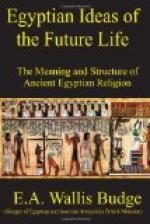Nepthys; and that Isis and Osiris, having a mutual
affection, loved each other in their mother’s
womb before they were born, and that from this commerce
sprang Aroueris, whom the Egyptians likewise call
the elder Orus, and the Greeks Apollo.
“Osiris, being now become king of Egypt, applied himself towards civilizing his countrymen, by turning them from their former indigent and barbarous course of life; he moreover taught them how to cultivate and improve the fruits of the earth; he gave them a body of laws to regulate their conduct by, and instructed them in that reverence and worship which they were to pay to the gods. With the same good disposition he afterwards travelled over the rest of the world inducing the people everywhere to submit to his discipline; not indeed compelling them by force of arms, but persuading them to yield to the strength of his reasons, which were conveyed to them in the most agreeable manner, in hymns and songs, accompanied by instruments of music: from which last circumstance the Greeks conclude him to have been the same with their Dionysius or Bacchus—During Osiris’ absence from his kingdom, Typho had no opportunity of making any innovations in the state, Isis being extremely vigilant in the government, and always upon her guard. After his return, however, having first persuaded seventy-two other persons to join with him in the conspiracy, together with a certain queen of Ethiopia named Aso, who chanced to be in Egypt at that time, he contrived a proper stratagem to execute his base designs. For having privily taken the measure of Osiris’ body, he caused a chest to be made exactly of the same size with it, as beautiful as may be, and set off with all the ornaments of art. This chest he brought into his banqueting-room; where, after it had been much admired by all who were present, Typho, as it were in jest, promised to give it to any one of them whose body upon trial it might be found to fit. Upon this the whole company one after another, go into it; but as it did not fit any of them, last of all Osiris lays himself down in it, upon which the conspirators immediately ran together, clapped the cover upon it, and then fastened it down on the outside with nails, pouring likewise melted lead over it. After this they carried it away to the river side, and conveyed it to the sea by the Tanaitic mouth of the Nile; which, for this reason, is still held in the utmost abomination by the Egyptians, and never named by them but with proper marks of detestation. These things, say they, were thus executed upon the 17th [Footnote: In the Egyptian calendar this day was marked triply unlucky.] day of the month Athyr, when the sun was in Scorpio, in the 28th year of Osiris’ reign; though there are others who tell us that he was no more than 28 years old at this time.
“The first who knew the accident which had befallen their king were the Pans and Satyrs who inhabited the country about Chemmis (Panopolis);




